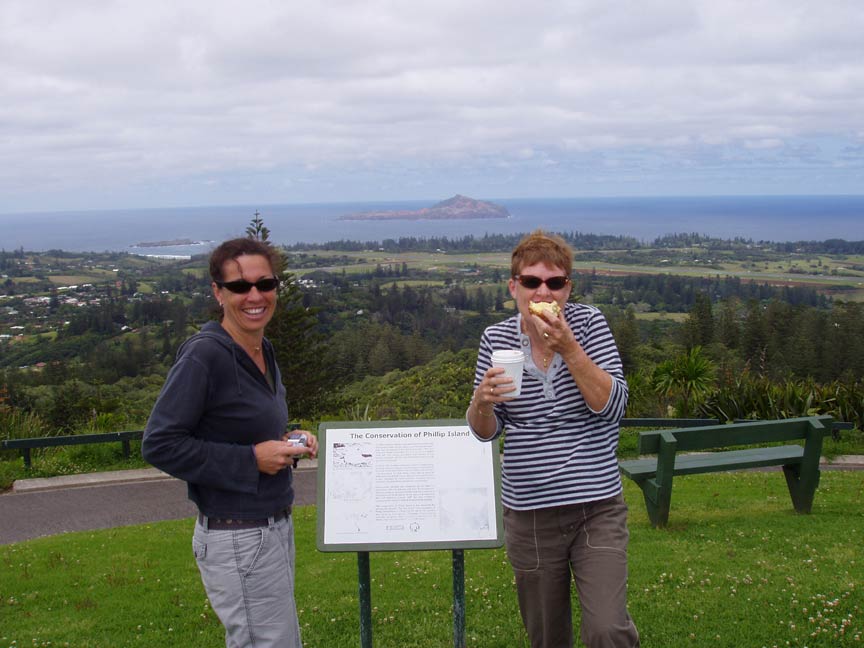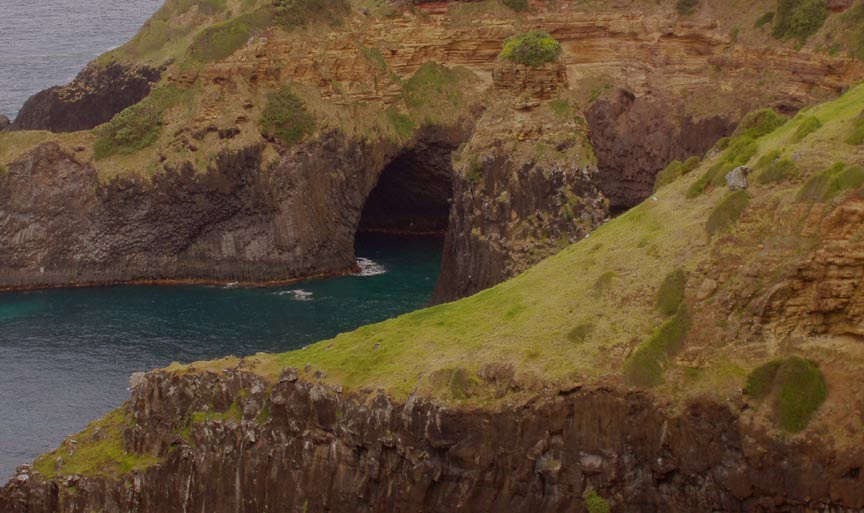Norfolk Island

Harmonie
Don and Anne Myers
Sat 18 Oct 2008 20:34
|
29:01.164S 167:58.363E
We arrived at Norfolk Island late the night of
October 17th and left around noon on the 19th, which gave us one full day to
tour the island. Not so difficult since the island's land mass is
only about twelve square miles. Sitting at 29 degrees south latitude,
Norfolk is subtropical with a mix of lush vegetation ranging from tree ferns and
palm trees to the towering Norfolk pine it is famous for (picture 1). The
island is an external territory of Australia lying about 800 miles to
the east of mainland Australia. It's a volcanic outcrop formed three
million years ago with a rugged coastline. When we left New
Caledonia, we left palm tree lined white sand beaches behind too
(sigh). One third of the island is a national park with all kinds of
walking trails. It is said that the snorkeling is good, but who wants to
jump in the water when there is no white sand beach and the air temperature is
only 75?
Like so many other South Pacific islands, Captain
Cook was the first European to discover Norfolk Island in 1774.
European occupation began with the establishment of a colonial penal colony like
New Caledonia (and Australia for that matter). This particular prison was
famous for the cruel treatment of its prisoners and the much less than desirable
conditions. This went on until 1855 when the prison was closed and the
Queen gave the Bounty mutineers and their descendants permission to move from
their overcrowded home on Pitcairn Island to a new home on Norfolk Island.
To this day, about one-third of the population on Norfolk Island is made up of
Bounty mutineer descendants (about 600 of the 1,822 Norfolk Island
inhabitants). This group still retains much of the culture that was
created by Bounty mutineers marrying Tahitian women. Some still speak the
Norfolk language which is a mix of Tahitian and 18th-century seafaring
English. We wish we could have stuck around long enough to get to know
some of these Bounty descendants and hear the Norfolk language -
which might even have been more fun than listening to pidgin
English Bislama in Vanuatu. The rest of the Norfolk Island population
is equally made up of New Zealanders and Australians.
There is one small town on the island, called Burnt
Pine (can only imagine how that name came about), an airport and about
seventy miles of roads. However, the tourist brochure does warn that
wandering cattle have the right of way (and we did see a few cattle wander in
front of us now and again). There are three bays suitable for anchoring
(depending on the sea and wind conditions), no real protected waters and
certainly no marinas. One of the bays has a pier, but based on the day we
were there, it's difficult to picture a boat actually tying up to it without
getting demolished in the process.
The four boats in our mini-rally anchored in
Cascade Bay, which is on the northeast side of the island and was the best
choice given the wind and wave direction. This particular bay is fairly
open to the ocean, and as we found out over time, the swell from the southeast
rounds the corner of the bay, rolls all the way up to where unsuspecting
boats are anchored, passes under them causing them to roll wildly, and then
goes on to crash on the shore. We've been in rolly bays before, but this
was by far the worst. By the second (and last) night, it was so bad
we had to sleep crosswise on our bed so we wouldn't roll out. Sleeping
crosswise may sound cozy, but in actuality, one person gets
squished between the back wall of the cabin and the other person,
while the other person does their best to keep their lower legs and feet
from falling off the side of the bed. All this while the boat rocks
madly from side-to-side, which is ok when your feet are tipped down and
your head up, but not so fun when blood rushes down into your head on the
opposite roll. All in all, not a lot of sleeping went on that night.
The other boats were rolling too, although not as much and Lady Kay hardly at
all (advantage of a catamaran). We spent some time on Storyteller Saturday
evening and nearly got seasick watching our boat rock almost
from rail-to-rail on each side (gave us a nice view of our peeling
bottom paint though).
Getting to shore was another experience to add to
our scary dinghy landing list. Worse than Niue and worse than Lugganville
in Vanuatu. About as bad as the dinghy ride from the port-listing
diesel-sucking tourist trawler to Bartolome Island in the Galapagos (except
there we had the Spanglish speaking guide and Ecuadorian boat driver to help us
out). Here, thankfully, we had Southern Princess and their mighty
hard-bottom dinghy with fifteen horsepower motor and Bob (friend of John on
Southern Princess who had been to Norfolk Island nine times before) and Terry
(ex-commercial fisherman friend of Storyteller) to ferry us around. Yes,
the landing and transit to the crumbling concrete pier was so scary that we
didn't even attempt it in our own dinghy. Once at the crumbling concrete
pier, you had to time your dinghy exit with the swell and hop out and up the
steps before the waves got you. If we were in our own dinghy, we
would have had to manhandle it and its 80 lb motor up the steps
and onto the crumbling concrete pier because it was impossible to leave a
dinghy in the water without it getting completely battered into the pier by the
waves. Hmmm....Don and I manhandling 125 lbs of dinghy and motor up
crumbling concrete pier stairs in between wave crashes. I don't think
so. If it weren't for the mighty Southern Princess dinghy and he-man crew,
we would not have gotten ashore. It definitely pays to travel by
mini-rally.
We started our day ashore with Sue from
Storyteller, who as (once again) the appointed tour guide and cultural
missionary, had gone in to town ahead of the rest of us to organize two
rental cars and gather all forms of tourist information in preparation for the
group's outing. We started off by getting acquainted with the New Zealand
style of muffin (giant and warm with a slab of butter in between two halves
- excellent) and coffee. Picture 2 is Sue enjoying said muffin and coffee
while taking in the fantastic coastline view with Chris (Storyteller friend
and wife of Terry). We then proceeded on a circumnavigation of the island,
stopping here and there for marvelous coastline views (pictures 3 and 4) and
historic buildings.
As we toured the island, this being our first stop
outside the tropics in a year and our first real step back
into civilization, we noticed some things that seemed entirely
odd. Exceptionally well maintained roads for example. And
no trash on display. Anywhere. Signs we could read. The
presence of signs at all. Green grass - great expanses of it - all mowed
and trimmed. People that spoke English as their first language.
Talkative waitresses and waiters. Talkative native restaurant patrons (all
were thrilled that we arrived on yachts as it is not a common occurrence - some
made a point of driving to the bay where we were anchored to view our four
lovely rocking boats). Restaurants with recognizable food. And
rules. Signs with rules. Lots of signs with rules.
Protective fences and danger signs. We stood on the edge of an active
volcano in Vanuatu and there wasn't a single sign, rule, fence, guard rail, park
ranger, legal waiver form in sight. Here, however, we were standing
well back from the edge of a moderately steep cliff face and there was a neatly
mowed patch of grass with a well-maintained wooden fence and 'DANGER -
STEEP CLIFFS' sign (picture 5). It's nice that the grass was mowed neatly
and the fence and sign were so aesthetically appealing - but honestly,
wasn't it obvious that we were standing near steep cliffs?
We finished our Norfolk Island circumnavigation by
lunchtime, and after a pleasant meal of recognizable food served outside by
a friendly waitress and surrounded by talkative Australian/New Zealander
transplants, Don went back to the boat to sort out the plugged toilet while the
rest of us went back to the National Park to take a long walk - we figured it
was our last chance for exercise before another 3-4 day stint on the boat.
Isn't it nice how smoothly that worked out? Don went back to the boat to
work on the plugged toilet while I went on a joy ride to the National Park and
frolicked through the woods. Perfect planning. Several hours later
we all arrived back at the boats (courtesy of the mighty dinghy and manly men)
to discover Don sipping a well earned scotch on Storyteller after successfully
unplugging the toilet.
Last but certainly not least - the toilet
story. The aft toilet (the one we use most
regularly) plugged a day or so after we left the Isle of Pines for Norfolk
Island. When we are at sea, anything that is flushed out of the toilet and
into the holding tank should easily flow out of the holding tank and
into the water by gravity. Unfortunately, something unmentionable was
plugging the outlet to the sea and the holding tank filled up and overflowed out
the top and into the head (bathroom). Although Don cleaned up the head,
and pumped the tank out into the sea using a handy portable hand
pump and hose stuck down into the tank from the pump-out fitting on
the deck (an unpleasant affair in and of itself), the tank outlet remained
plugged. So, while I was frolicking through the woods in Norfolk Island
National Park, Don endeavored to unplug the outlet on the bottom of the
tank. His instrument of choice was a boat hook with an unraveled wire coat
hanger attached to it using highly acclaimed, all-purpose, problem-solving
duct tape. He then spent a pleasant forty-five minutes bent over the rail
on the side of our severely rocking and rolling boat trying to stick the point
of the coat hanger up into the holding tank outlet thru-hull - which of course
he couldn't see. In a way, I wish I was there to witness this feat because
I'm sure I'm not adequately describing the pain and agony Don must
have endured while bent over the rail wielding the boat hook before he
successfully maneuvered the coat hanger end into the thru-hull. Of course
when he did get the coat hanger into the thru-hull it wasn't just a simple
matter of wiggling it a bit and clearing the clog. Oh no, it required a
bit more skill than that. Quite a few jabs, wiggles and heaves were
necessary before success was finally had. Shortly
thereafter, John on Storyteller called Don on the radio and asked if he
wanted to join he and Terry for an evening drink (John and Terry had remained
aboard Storyteller to repair their headsail). If the water had been
warmer, Don probably would have jumped over the side and swam over to
Storyteller in anticipation of that scotch. Fortunately though, Terry
wasted no time in ferrying Don from Harmonie to Storyteller in the
mighty Southern Princess dinghy. And so this toilet story ends
happily with Don and I enjoying a sunset drink in the cockpit of Storyteller
while watching Harmonie happily rock and roll in the swell, unplugged
toilet and all.
Anne
|




